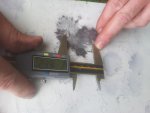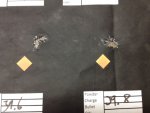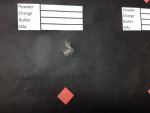Help Wanted!!
So gents here is the story of the 6xc woes. This rifle is a remington 700 remage build/manners t4 adjustable (glass/pillar bedded)/ timney trigger, criterion 26in varmint barrel. This rifle will shoot lights out on new factory norma brass as seen in the sample images (steel was 800yd 3 shot)loaded with either 105 hybrids or 107 sierras and 39.8gr of H4350 fed 210 primers. The problem occurs when i try to reload the brass being it will not group nearly as well(upwards of 1 MOA or more and really bad jumps at distance), and i have done this with about 5 batches of 100 brass now. My brass prep goes as follows:
Vibratory clean
Deprime/size .002 bump forster dies (not sized if i plan to anneal yet) (anneal if needed, i have tried annealing after first firing to no different affect)(bench source)
Ultrasonic clean (usually wait outside in sun for couple hours to dry or overnight inside)
Trim RCBS trimmer (within .001")
Chamfer inside and out using VLD inside chamfer and rcbs outside debur. (these are motorized)
Flash hole chamfer
Primer pocket depth uniformer
Hand prime with RCBS tool ( i actually notice the new 6xc norma brass is the tightest pocket of any brass i have ever reloaded for in my life)
Load using rcbs chargemaster and rcbs press.
My new brass out of box prep goes:
Size all (basically to just round out the mouths)
ultrasonic
quick debur inside and out
primer pocket
prime
load
I cant believe i am hurting these somehow on the second load that i dont on the first but i am open to any ideas right now. I do reload for other calibers and rifles (dpms lr-260/fna3g/various hunting rifles ) and i dont see these issues. One thing i do notice is the bullets seat as smooth as butter on new brass but on my first reload they do take more force to seat. It seems smooth, not like new brass but smooth enough however its just a little harder. Runout is good all under .003 most under .002". seating depth is uniform. The expander ball on my forster die is .2405" and leaves the inside case neck .240". I didnt measure any new norma neck size. Thoughts?
So gents here is the story of the 6xc woes. This rifle is a remington 700 remage build/manners t4 adjustable (glass/pillar bedded)/ timney trigger, criterion 26in varmint barrel. This rifle will shoot lights out on new factory norma brass as seen in the sample images (steel was 800yd 3 shot)loaded with either 105 hybrids or 107 sierras and 39.8gr of H4350 fed 210 primers. The problem occurs when i try to reload the brass being it will not group nearly as well(upwards of 1 MOA or more and really bad jumps at distance), and i have done this with about 5 batches of 100 brass now. My brass prep goes as follows:
Vibratory clean
Deprime/size .002 bump forster dies (not sized if i plan to anneal yet) (anneal if needed, i have tried annealing after first firing to no different affect)(bench source)
Ultrasonic clean (usually wait outside in sun for couple hours to dry or overnight inside)
Trim RCBS trimmer (within .001")
Chamfer inside and out using VLD inside chamfer and rcbs outside debur. (these are motorized)
Flash hole chamfer
Primer pocket depth uniformer
Hand prime with RCBS tool ( i actually notice the new 6xc norma brass is the tightest pocket of any brass i have ever reloaded for in my life)
Load using rcbs chargemaster and rcbs press.
My new brass out of box prep goes:
Size all (basically to just round out the mouths)
ultrasonic
quick debur inside and out
primer pocket
prime
load
I cant believe i am hurting these somehow on the second load that i dont on the first but i am open to any ideas right now. I do reload for other calibers and rifles (dpms lr-260/fna3g/various hunting rifles ) and i dont see these issues. One thing i do notice is the bullets seat as smooth as butter on new brass but on my first reload they do take more force to seat. It seems smooth, not like new brass but smooth enough however its just a little harder. Runout is good all under .003 most under .002". seating depth is uniform. The expander ball on my forster die is .2405" and leaves the inside case neck .240". I didnt measure any new norma neck size. Thoughts?
Attachments
Last edited:




